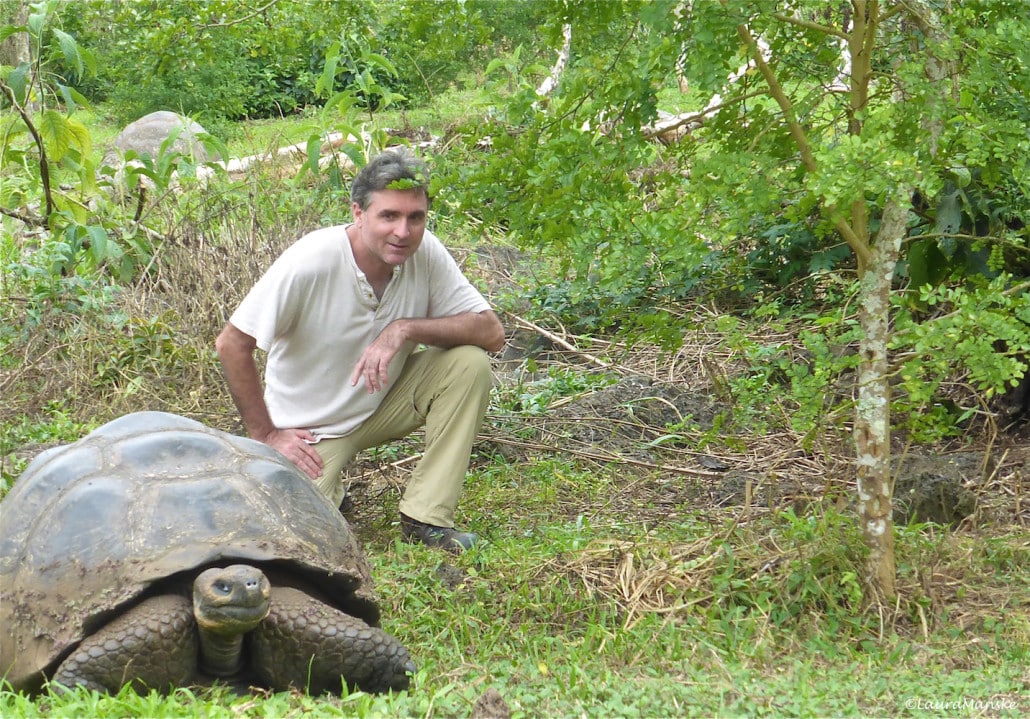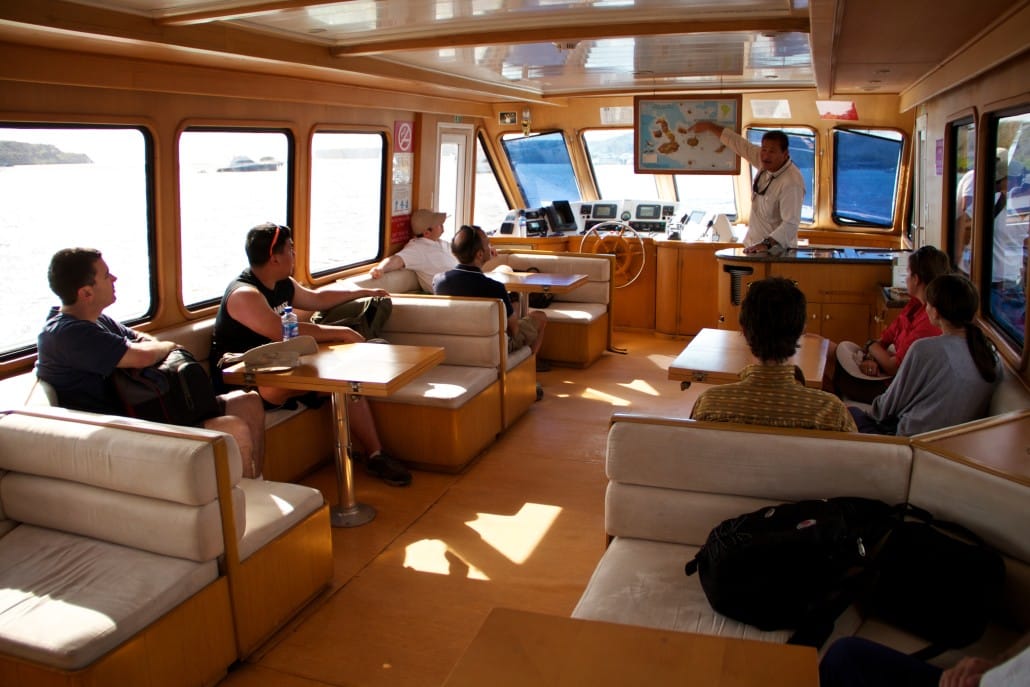
Veteran guides’ advice—the who, what, when, where—for seeing the “big 15” animals, as curated and then applied by contributor Bruce Northam.
Timing an optimum visit to the Galápagos can be a challenge. It’s also an underreported story. There’s more to see than just two-ton tortoises and dragon-like iguanas. Klaus Fielsch, former head of guides for Metropolitan Touring and an expert on all things Galápagos, is part of a team of veteran guides that has developed a tool—this tool—to help people who typically show up in the Galápagos unarmed with any knowledge of how to fulfill their wish lists. In fact, most tourists arrive only with factoids and misinformation.
The wildlife-timing Big 15 tool, which helps users in experiencing the Galápagos’ 13 accessible islands, was developed via a survey of trusted guides and expedition leaders from a company with 46 years of experience showcasing these islands. Factors include time of year, type of boat and the emerging popularity of a land-based experience that blends a hotel stay with day tours. Rather than focusing on price ranges, Klaus’ simple layout of options simplifies itineraries. Therefore, customers are practically guaranteed an epic experience and are never treated like mere commodities. Start strategizing here—and read on for a Q&A with the man behind it:
Q: In terms of wind, rough water and season, when is the worst time to visit the Galápagos—and the best?
A: This is possibly the most common question, and the answer is simple: the best time to travel to the Galápagos is when you have time to travel to Galápagos. And there is no worst time to travel. Let me expand a bit more about this. The Galápagos is located right on the equator. This means we don’t have the four seasons. There is seven minutes between the longest and the shortest day of the year. So most species here don’t have a time restriction as to when to mate. These are known as opportunistic breeders. Any month of the year shows remarkable activity every year. The only seasonal changes are linked to ocean currents. When it’s summer in the northern hemisphere, the Galápagos is surrounded by cool, nutrient-rich waters that originate in the Antarctic. Marine species are in their ideal elements, and our guests’ are provided wetsuits to cope with this. The days are a bit cooler, too, and it’s advisable to bring a windbreaker for the early and later hours of the day. Days are a bit windier too—for equatorial standards that is—never too strong! During the northern hemisphere winter, Galápagos is influenced by a warm-water current that originates in Central America. Warm water evaporates into bulky clouds that precipitate over land, then we have clear skies until the next strong rain. It’s ironic that during these months (December to April), rains turn Galápagos green, but we have more hours of clear skies than during the dryer months (April to December).
Q: How long should someone plan to stay in the Galápagos?
A: Be generous when planning a visit to the Galápagos. If seeing all of the visit-friendly islands is too time-consuming, at least try to get the highest species exposure in your itinerary, which means at least four nights. But remember that most of the four-night guests agree, when their trip comes to an end, that they should have booked extra time. To see all of the “big 15,” you may want to connect two itineraries.
Q: How varied is the recommended timing regarding visiting the tourist-approved islands, and how different are they?
A: The Galápagos archipelago consists of 19 main islands and hundreds of islets with an area of 3,040 square miles of land spread over 17,000 square miles of ocean. Ninety-seven percent of this land surface has been protected since 1959 by the National Park and is uninhabited (there’s a small permanent population of 26,000 inhabitants scattered among parts of four islands). The Galápagos National Park is the only institution ruling over conservation and sustainable tourism in the Galápagos. It controls how many people can enter the National Park and how many ships can operate within the park, and trains and licenses all naturalist guides. Since 1996, it has approved a total of 145 visit sites (70 land visiting sites and 75 marine visiting sites). The 70 land visiting sites are present in only 12 islands and 4 islets. Some are certainly more exciting in terms of wildlife exposure than others. Some have a fabulous effect if connected appropriately so the trip has a logical script of its own, and like a novel, it includes magical highlights at the right intervals with juicy interludes in between. Some sites are better in the morning, because they can be combined with snorkeling. In some sites, the National Park allows kayaking and glass-bottom boat rides. As you can sense, there’s a wide range of options (hence, the aforementioned touring tool).
Q: What is one thing that most visitors never figure out about the Galápagos?
A: You cannot see everything in only a few days. And seeing more islands might actually mean seeing less of what you came for. If the itineraries are well-balanced, you could combine two or three itineraries together and not feel as if you’re starting to repeat things. Every island is different regarding its species roster and volcanic scenery.

Well, I took Klaus’ advice and chose a land-based Galápagos experience, staying at the beachfront Finch Bay Eco Hotel, which has been awarded South America’s greenest hotel, three years running. I had no idea that a resort with a focus on ecology could be so plush—and have such amazing cuisine. Kayaks await on the beach, and the daytrip boat excursions to various islands do not disappoint.

The Galápagos is about unparalleled encounters with wildlife that defy the imagination and expand your awareness of the color spectrum. Previously, I saw a Galápagos Tortoise in Bermuda, experienced a fantasy of underwater colors on Australia’s Bougainville Reef, witnessed Antarctica’s penguin frenzy, smelled San Francisco’s sea lions, and beheld the exotic birds of Borneo. But, here they all cooperate in symphony with a twist—adding colors that are usually atypical in nature like bright red crabs on black volcanic rocks sharing real estate with slumbering, snuggling sea lions, then spicing in out-of-this-world iguanas (cute dinosaurs).
These animals have no fear. They stare right back at you, peering deep into your eyes. On reflection, having so many animals returning my gaze is what made coming here so worthwhile. The two-ton Galápagos Tortoise, with its huge snake-like head and pig nose, lumber about—when they pause to ponder you, time stands still. This reprieve was a good time to test my traveler pun: “So, did you hear the one about the hardened backpacker?”

The Finch Bay’s general manager, Tito, noted the resort’s “hippie visitor” beginnings, and his continuation of that special blend of Ecuadorian spirituality. Tito also pointed out that only 5% of mainland Ecuadorians will visit the Galapagos in their lifetime. This under-the-radar resort, minutes away from the buzz of Puerto Aroya, is still a world away. It costs 60 cents to ride the plentiful mini-ferries into town. These water taxis are inherently more social than a plane or bus.
Puerto Aroya is a small town that’s still mostly a fishing village happily held hostage by a national park. For example, 3% of this entire territory is accessible to visitors. Just a few blocks outside of Puerto Aroya’s tourist quarter, career fisherman are busy at work while land-lubbing sea lions are as ubiquitous as stray dogs in Bali. There are also epic wildlife encounters in town; at the public fish market, while peddling fish, a female vendor simultaneously gives a purring-with-pleasure squinting “pet” sea lion a head rub.
PS: No need to pack socks, or worries.

Sept 2019 I just returned from GALAPAGOS. I am a 75 year old solo traveler that had it on my bucket list. Better now than later. (walking on the islands took a lot of balance and dexterity-especially on LAVA ROCKS) The SANTA CRUZ II cruise ship (90 psgr) was great. Naturalists were very knowledgeable. There was lots of activities to do and wildlife to see each day. I contacted a travel agency online one week in advance and went last minute. Flying from the West Coast (CA) is a bit of a challenge. Guayaquil Ecuador GYE is the closest large airport–and requires an overnight (or more) before flying to BALTRA GPS where cruises begin—GOOD LUCK to others
Great post. I would love to see these islands especialy as they are the birthplace of theory of evolution.
Unfortunately seems like a very difficult and remote place to travel.
Neno